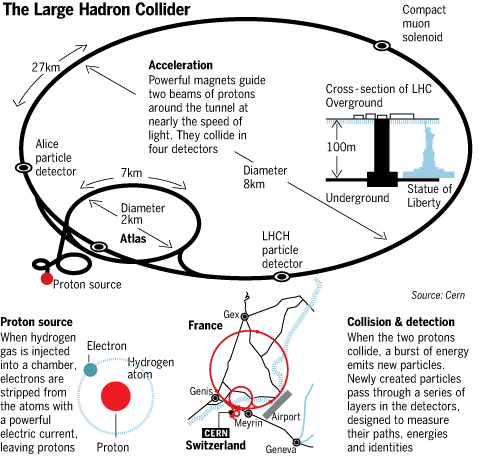Scientists look to the spin-offs of a miniature ‘big bang’
By Clive CooksonPublished: September 4 2008 18:27 | Last updated: September 4 2008 18:27
In their quest to understand the secrets of the universe, physicists are about to launch their biggest experiment. Next Wednesday, the first atoms will race round a 27km track beneath the Swiss-French border outside Geneva, at almost the speed of light.
It will be the first step towards the real moment of truth for the $8bn (£4.5bn, €5.6bn) Large Hadron Collider. In a few weeks, two beams of protons – hydrogen nuclei – will accelerate in opposite directions and smash together, creating in miniature the intense energies of the newborn universe just after the “big bang” some 14bn years ago.
Scientists at Cern, the European centre for particle physics, hope the LHC will reveal new forces and even extra dimensions of space and time. It may also enable researchers to produce and study miniature black holes.
Yet the LHC may eventually be a final flourish for Cern – and indeed for the whole of particle physics – after a glorious half-century in which increasingly powerful atom smashers enabled scientists to build up a coherent, though incomplete, understanding of the universe, based on studying the smallest building blocks of matter.
Some influential scientists are already suggesting that the world will not be able to fund another large-scale accelerator. “We need a re-evaluation,” says Sir David King, former UK chief scientist. “We have to ask: what is the end-point for particle physics? How big do we have to go?”
In an increasingly pragmatic world, governments have already been directing more money to applied science and technology, while cutting spending on fields aimed essentially at advancing knowledge for its own sake. The cancellation of the US Superconducting Super Collider in Texas 15 years ago left Cern the field’s undisputed global centre.
Lyn Evans, LHC project leader and a 38-year Cern veteran, says: “The only way we justify our existence is to build more and more powerful machines on a budget that is constant in real terms.”
Not surprisingly, Cern scientists often feel compelled to defend their spending in terms of its direct spin-offs, such as the high-speed computing grid that will handle the vast data flow from LHC. (Cern also loses no opportunity to remind people that the world wide web was invented there in 1989.) But “the real reason is to satisfy intellectual curiosity,” says Jos Engelen, Cern chief scientist.

Big spin-offs from the LHC, if any, will occur far in the future, in ways that we cannot predict or even comprehend today. “Who is to say that the strong nuclear force [being investigated by Cern] will not be propelling spaceships across the galaxy in 300 years?” asks David Evans, senior scientist at Alice, one of four giant underground detectors built to analyse the particles produced by LHC collisions.
Putting a comprehensible intellectual case for the LHC is extremely difficult if not impossible. Yet particle physicists have to make the effort. Government funding decisions today depend on public understanding and political support much more than they did after the second world war, when European governments set up Cern as a centre for peaceful research into atomic physics.
At the heart of the case is the “standard model” – a framework of fundamental particles and forces that provides a partial explanation for the way the universe works but does not cover gravity. It also fails to account for recent observations such as the mysterious “dark matter” that appears to dominate the universe.
First order of business for the LHC will be to fill in gaps in the standard model. The best known gap is what gives matter its mass. Favourite here is the fabled Higgs boson, a particle originally proposed in the 1960s, which – if it exists – should be accessible within the LHC’s energy range.
But physicists disagree about where the LHC is most likely to move the field next. Robert Aymar, Cern’s director-general, likes supersymmetry. According to this theory the LHC should be able to make and detect at least the “neutralino” – a massive yet elusive particle that is a leading candidate for filling the universe with dark matter.
His deputy Jos Engelen, on the other hand, is rather dismissive of this. He is a fan of string theory, according to which our four familiar dimensions of space and time conceal several extra dimensions, which might conceivably open up in the extreme conditions of LHC collisions. Under these circumstances, the particles associated with gravity might reveal themselves for the first time.
Slightly easier for the lay mind to understand is the prospect that the LHC will produce microscopic black holes – tiny concentrations of matter so dense that their gravity prevents light escaping. Then Stephen Hawking, the leading black hole theorist, could expect to win a Nobel prize.
However, black holes carry a fear factor that has provoked lawsuits in the US and Europe seeking to stop the LHC from opening. The project’s opponents argue that the collisions could generate black holes capable of swallowing up the whole earth.
Cern recognises that there is genuine concern but insists that the risk of catastrophe is zero. “If you look at the blogosphere, you will find a lot of people taking the threat seriously,” says John Ellis, Cern’s leading theoretician. “But there is no evidence for any conceivable threat from the LHC.”
While large black holes at the centre of galaxies can suck up whole stars, their microscopic counterparts would be unstable and disappear, Cern insists.
The best outcome would be for the LHC to spring a stupendous surprise that does not threaten the planet. But particle physicists would not want the project to answer all the big questions. From their point of view, the universe should be left with enough secrets to justify spending billions of dollars on the next giant experiment.
Source and Related Articles:-
- Creating Big Bang to Understand Physics
- Worlds Biggest Scientific Experiment - Big Bang
- What if our experiment go wrong?







No comments:
Post a Comment